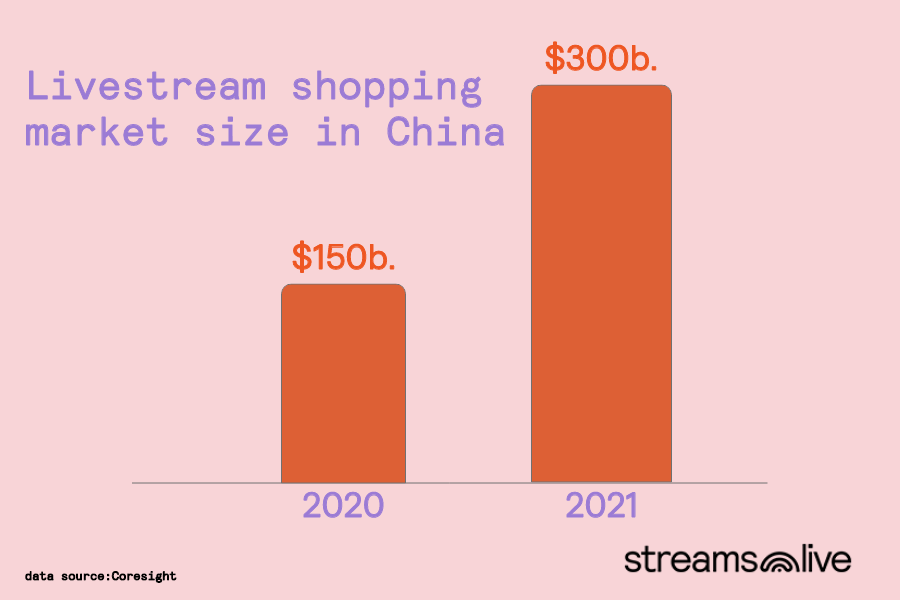
The Covid-19 pandemic has brought tremendous changes in the social and economic sectors worldwide. But, as stores closed due to the lockdowns in multiple countries, businesses started moving online. As a result, the world has seen a steady increase in the e-commerce market size in general and the livestream shopping market size in particular during this period. Indeed, as per the figures mentioned by UNCTAD in its report on ‘Estimates Of Global E-commerce 2019 And Preliminary Assessment Of Covid-19 Impact On Online Retail 2020’, the shares of online retail sales have shot up from 16% to 19% (of total retail sales globally) in 2020.
E-commerce, or the buying or selling of goods online, is not a new concept. But as a result of the pandemic, it is now assumed to be much more important than ever before. And as can be analyzed from the growth trends, this popularity is here to stay.
Online marketing will rise steadily over the next few years as businesses experiment with new strategies for showcasing their products and services to their customers. And live stream marketing is all set to be the new big thing within e-commerce – as more and more brands in the US and other parts of the world embrace it.
What Is The Current E-commerce Market Share?
As per figures published by Statista, the global retail market sales for 2019 were around 25 trillion US dollars. And this figure is expected to reach a figure of around 27 trillion US dollars by 2022. However, while overall the statistics indicate an upwards trend, the retail market suffered an initial setback in 2020 due to the global Covid-19 pandemic.
But while physical shops closed down, online stores thrived. And as social distancing became the norm, people went digital, causing a boost in e-commerce sales figures. As per Statista, the share of e-commerce in 2020 was around 18 percent of the total retail sales worldwide, and it is anticipated to go up to 21.8 percent by 2024.
The global retail e-commerce sales figures amounted to around 4.28 trillion US dollars in 2020. These figures might go upwards, with the projected figures for 2022 being about 5.4 trillion US dollars globally.
In the US, too, the popularity of e-commerce is on the increase. As per the figures from the first quarter of 2020, eCommerce had a share of around 11.4% of the total retail sales in the USA. By the second quarter, the figures had risen to 15.7% – a direct result of the pandemic’s restrictions in place. As of the first quarter of 2021, the figures stand at 13.6% of the total retail sales, which amounts to around 215 billion US dollars.
Why is the livestream shopping market size growing?
The e-commerce industry has been rising gradually in the last decade due to the popularity of smartphones and improvements in internet connectivity and speed. But while people enjoyed the convenience of shopping from wherever they are, offline shopping remained the more preferred option for a major chunk of people.
While e-commerce had seen an upward trend over the years for various reasons, the outbreak of the Covid-19 pandemic gave it an enormous boost. As the viral outbreak spread gradually from China to the rest of the world, social distancing and travel restrictions, in addition to the general panic among the masses, led to a drastic dip in in-person shopping in stores. Subsequently, the number of online sales shot up, as you can see from the figures mentioned above.
But as the e-commerce industry continues to thrive, brands are reaching out to new modes of presenting their products to their customers. And as of the present scenario, live streaming is one of the hottest trends worldwide. With more people opting for online shopping via social media and other platforms, the livestream shopping market size has grown by leaps and bounds worldwide.
The Ever-Growing Popularity Of Livestream Shopping
While e-commerce had grown over the years, one major issue that kept it behind in-person shopping was the lack of interaction. Indeed, online shopping was primarily restricted to text descriptions and images. And unlike browsing in stores where the customer could determine the product’s look and feel, online browsing did come with its disadvantages.
But with more and more brands embracing live streaming during the ongoing pandemic, the customers are in for a welcome change. The live stream shopping market size has increased tremendously in recent years, especially in countries like China with an explosive e-commerce industry. Gradually more countries worldwide, including the US, are embracing this interactive mode of e-commerce to boost sales figures.
Livestream shopping is based on a relatively simple concept. It is a combination of watching a live video with an option for directly making a purchase. In addition, customers can view any product being showcased in real-time and interact with the host through likes and comments.

When Did This Trend Begin?
While it is hard to affirm when the concept of live stream shopping started, it has become a popular trend by 2019. With numerous social media platforms offering options for live streaming, celebrities and influencers could showcase their products directly to their viewers, who had the option of purchasing during the live broadcast.
China was the first country to embrace this trend on a large scale. The penetration of live streaming in the country’s e-commerce industry was made more accessible by the mobile usage habits of the population. The live stream market in China is currently dominated by Taobao, with more than 60% of online shoppers purchasing a product from watching a live stream on the platform.
Amazon was among the first platforms to embrace live streaming in the US, launching Amazon Live in early 2019. And this mode of online purchasing is on the rise as more and more customers are looking for new, interactive ways of buying online.
The Current Position
While livestream shopping had become one of the more popular modes of e-commerce in China in 2020 itself, other countries were relatively slow to follow. But, as face-to-face interaction stands restricted in the current pandemic scenario, brands from all over the world are moving towards incorporating live streaming as part of their sales strategies.
In the US, for example, the livestream shopping market size is growing as brands like Nordstrom, Avon, Walmart, and many more have embraced it to boost their sales. According to research data by Coresight, the live-streaming market in the USA is expected to reach around 11 billion US dollars. And the figures may steadily increase to approximately 25 billion US dollars by 2023.
While this is still a far cry from the livestream shopping market in China, which reached close to 150 billion US dollars in 2020 and is expected to go up to around 300 billion US dollars in 2021, the global surge of live streaming is should not be neglected.

What Makes It So Popular?
Live video makes online shopping more interactive. It brings together the good parts from both online and offline shopping to improve the experience of customers. It provides customers with the option to directly engage with the live stream host through comments, polls, etc. It also ensures that any question or request about the product gets addressed during the live event.
Live streaming adds to the trustworthiness of a brand or product. You see, one major disadvantage of shopping online is that often the displayed images are edited to make them more appealing. And since customers place orders based on such images, they may feel cheated when they receive the actual product.
Live streaming, on the other hand, shows you the product live, thereby minimizing the chances of photoshopping or editing. It is much like displaying a product by a salesperson in a store, where you get to see precisely how the product is. And all this from the comfort of your home.
And you get to do it at your convenience. Since you can access it on multiple devices (laptops, smartphones, tablets), you can watch the live stream from wherever you are.
Live streams are advantageous for brands too. The absence of face-to-face interactions allows them to demonstrate their products just the way they want to, highlighting their uniqueness or special features. And it is not restricted to any particular category of products.
Summing up on livestream shopping market size
To sum up, it is evident from the available stats that the livestream shopping market size is on the rise. While China dominates a significant portion of this market, countries like the USA are steadily moving towards this customer-friendly approach of increasing sales.
While the Covid-19 pandemic has directly contributed to the growth of popularity of live stream shopping, this trend is unlikely to decline even in the post-pandemic world. Instead, the interactivity and authenticity offered by live streams are expected to attract more customers, thereby ensuring that it occupies a sizable share of the global e-commerce sales figures in the future.





